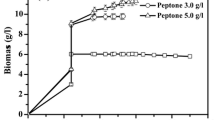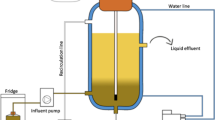Abstract
Various processes which producel-lactic acid using ammonia-tolerant mutant strain,Rhizopus sp. MK-96-1196, in a 3 L airlift bioreactor were evaluated. When the fed-batch culture was carried out by keeping the glucose concentration at 30 g/l, more than 140 g/l ofl-lactic acid was produced with a product yield of 83%. In the case of the batch culture with 200 g/l of initial glucose concentration, 121 g/L ofl-lactic acid was obtained but the low product yield based on the amount of glucose consumed. In the case of a continuous culture, 1.5 g/l/h of the volumetric productivity with a product yield of 71% was achieved at dilution rate of 0.024 h−1. Basis on these results three processes were evaluated by simple variable cost estimation including carbon source, steam, and waste treatment costs. The total variable costs of the fed-batch and continuous cultures were 88% and 140%, respectively, compared to that of batch culture. The fed-batch culture with highl-lactic acid concentration and high product yield decreased variable costs, and was the best-suited for the industrial production ofl-lactic acid.
Similar content being viewed by others
References
Miura, S., T. Arimura, M. Hoshino, D. Lies, and M. Okabe (2003) Optimization and scale-up ofl-lactic acid fermentation by mutant strainRhizopus sp. MK-96-1196 in airlift bioreactors.J. Biosci. Bioeng. 96: 65–69.
Miura, S., L. Dwiarti, T. Arimura, M. Hoshino, T. Liu, and M. Okabe (2004) Enhanced production ofl-lactic acid by ammonia tolerant mutant strainRhizopus sp. MK-96-1196.J. Biosci. Bioeng. 97: 19–23.
Ohara, H. (1994) Poly-l-lactic acid as biodegradable plastic.Biosci. Ind. 52: 642–644.
Hamamuci, H. and D. Y. Ryu (1993) Production ofl(+)-lactic acid using immobilizedRhizopus oryzae.Appl. Biochem. Biotechnol. 44: 125–132.
Sun, Y., L.-Y. Li, and S. Bai (1999) Modeling of continuous L(+)-lactic acid production with immobilizedRhizopus cryzae in an airlift bioreactor.Biochem. Eng. J. 3: 87–90.
Yuru, C., X. Liming, and C. Peilin (2000)l-Lactic acid by immobilizationRhizopus oryzae in a three-phase fluidizedbed.Acta Microbiol. Sinica 40: 415–419.
Futamura, T., H. Ishihara, T. Takayoshi, T. Yasutake, G. Huang, M. Kojima, and M. Okabe (2001) Kojic acid production in an airlift bioreactor using partially hydrolyzed raw corn starch.J. Biosci. Bioeng. 92: 360–365.
Kosakai, Y., Y. S. Park, and M. Okabe (1997) Enhancement ofl(+)-lactic acid production using mycelial flocs ofRhizopus oryzae.Biotechnol. Bioeng. 55: 461–470.
Park, E. Y., Y. Kosakai, and M. Okabe (1998) Efficient production ofl(+)-lactic acid using mycelial cotton-like flocs ofRhizopus oryzae in an airlift bioreactor.Biotechnol. Prog. 14: 699–704.
Buchita, K. (1983) Lactic acid. pp. 409–417. In: H.-G. Rehm and G. Reed (eds.).Biotechnology 1st Edn. Verlag Chemie, Weinheim, Germany.
Author information
Authors and Affiliations
Corresponding author
Rights and permissions
About this article
Cite this article
Liu, T., Miura, S., Arimura, T. et al. Evaluation ofl-lactic acid production in batch, fed-batch, and continuous cultures ofRhizopus sp. MK-96-1196 using an airlift bioreactor. Biotechnol. Bioprocess Eng. 10, 522–527 (2005). https://doi.org/10.1007/BF02932288
Received:
Accepted:
Issue Date:
DOI: https://doi.org/10.1007/BF02932288




